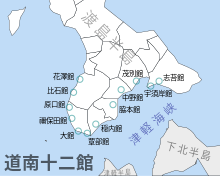| This article needs additional citations for verification. Please help improve this article by adding citations to reliable sources. Unsourced material may be challenged and removed. Find sources: "Twelve Garrisons of Southern Hokkaido" – news · newspapers · books · scholar · JSTOR (June 2021) (Learn how and when to remove this message) |

The Twelve Garrisons of Southern Hokkaido (Japanese: 道南十二館, "Twelve Garrisons of the Southern Circuit") was a general term encompassing the Japanese feudal possessions in southern Ezo (now Hokkaido). The names come from the "Shinra no Kiroku" which describes the history of the Matsumae Domain. It is distributed along the southern coastline of the Oshima peninsula facing the Tsugaru Strait, from the Shimosa Garrison in Hakodate to Hanazawa Garrison in Kaminokuni. These garrisons were possessed by the Ando clan and were important sites for trade between Japanese merchants and the indigenous Ainu.
List of garrisons
| Name | Owner during Koshamain's War | Location | Building date | |
|---|---|---|---|---|
| Usukeshi (宇須岸館) | Masamichi Kono | Hakodate City | ~1450s | |
| Mobetsu (茂別館) | Ando Iemasa | Hokuto City | 1445 | |
| Nakano (中野館) | Kikinori Sato | Kikonai | 1443 | |
| Wakimoto (脇本館) | Kisetsu Nanjo | Shiriuchi | ||
| Innai (穏内館) | Kinnao Jindo | Fukushima | ||
| Oyobe (覃部館) | Kitomo Imai | Matsumae | ||
| Ōdate (大館) | Ando Sadasue | Matsumae | ||
| Nebota (禰保田館) | Kisetsu Kondo | Matsumae | 1400 | |
| Haraguchi (原口館) | Kisumi Okabe | Matsumae | ||
| Hiishi (比石館) | Shigemasa Atsutani | Kaminokuni | ||
| Hanazawa (花沢館) | Kiyoshi Sugisaki | Kaminokuni | ||
| Shinoridate (志苔館) | Yoshikage Kobayashi | Hakodate City | 1443 |
History
In the middle of the 10th century, the Aonae culture, a creole between the Satsumon culture and the Haji pottery culture of Honshu, was established as the pre-stage of the establishment of the Ainu culture. The migration of Japanese to the Oshima Peninsula occurred from the end of the Kamakura period to the middle of the Muromachi period. From archaeological records, it is estimated that Japanese migration began in earnest after the late 14th century during the Muromachi period.
The Hokkaido Japanese then were under the control of the Ando clan. In 1454, Masaki Ando was chased by the Nanbu clan and moved to Hokkaido, where he assigned his generals to twelve garrisons: Ando Iemasa of Mobetsu garrison was to be the guardian of Lower Ezo, and Kiyoshi Sugisaki of Hanazawa garrison was to be guardian of Upper Ezo.
The garrisons came under serious threat during Koshamain's War: ten of the twelve garrisons were captured in 1457. However, in the following year, Koshamain was defeated by Nobuhiro Takeda's army.
In 1593, Matsumae Keihiro of the Oyazaki clan was appointed by Toyotomi Hideyoshi as the presiding lord of Ezo, leading the Ando clan to gradually lose control of Ezo.
After that, the Hokkaido Japanese established the Matsumae Domain, and the twelve garrisons fell out of use and became abandoned.
References
- Takuro, Setakawa (2007). History of the Ainu's Sea and Treasure Nomads. Kodansha Selection Book Mechie. p. 40.